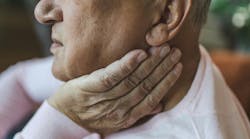Endodontic program expanded
The Department of Endodontics at the University of Illinois at Chicago College of Dentistry has added tests on the Internet, case presentations, and self-evaluations to the endodontics portion of DDS students' training at the college.
In the past, when the College of Dentistry gave an Objectively Structured Clinical Examination (OSCE) which included a section on Endodontics, students were forced to rotate from workstation to workstation.
"They would look at photographs, radiographs, documents, or casts of teeth at each workstation and answer questions," explained Dr. Michael J. Barrows, Assistant Professor, Department of Endodontics. "And then a bell would ring and they'd rotate to another station. It was a system that was time-consuming both in its planning and execution."
With every workstation in the clinics at the College now equipped with a computer, Dr. Barrows thought, "What if we had an OSCE exam in which students could stay at their own unit and actually progress through the OSCE on their own time?"
Dr. Barrows consulted the Blackboard Academic Suite at www.blackboard.com, which enables universities to host classes and give quizzes and tests on the Internet.
He compiled a quiz "and interfaced it with some HTML pages that I had made of cases that had been dealt with in the Department of Endodontics," he explained. "We would have a case with a radiograph, for example, and there would be a question pertaining to it with multiple choice answers. The students would select the answer, and Blackboard would tabulate their scores."
Dr. Frank Licari, Executive Associate Dean for Academic Affairs, and Dr. Christopher Wenckus, Head, Department of Endodotnics, liked the work Dr. Barrows had done up to that point, and decided on a trial run.
"The test was password protected; we gave every student the password the day of the exam and set the timer on Blackboard," Dr. Barrows explained. "Students sat at their own units, logged in, read the directions, and took the test. The preparation time was high for me for this first test, but students' time spent on it was cut drastically."
The test was a success, and so the computerized OSCE examination has been incorporated into the first endodontic clinic course, Endodontics 352.
"The Blackboard program scores the students' answers and then puts them on a grade sheet," Dr. Barrows said. "We loaded feedback related to each right and wrong answer into the program, and for each one, the program told the student why their answer was right or wrong."
Like paper or clinical tests, the computerized tests can be changed. "Faculty provide me with different radiographs of different cases and we come up with different scenarios and different questions and put them on the test site," Dr. Barrows said.
Through Tigger, another Internet server, Dr. Barrows encrypted the HTML clinical radiographs and photos.
"By using both a Blackboard website and a Tigger website, and through adding another HTML security program, the tests are secure, and a student cannot copy the questions or the pictures. It's working out very well," Dr. Barrows said.
With the students spending increased amounts of time doing extramural rotations into community clinics, "we could no longer give them daily grades like we used to in their senior year because they're just not here enough," explained Dr. Barrows.
"By the time they are in the third endodontic clinic course, Endodontics 363, they're out in the community. So we were looking for other things to mark their progress rather than endodontic clinical work."
The Department of Endodontics now, therefore, requires students to put together an endodontic case presentation. The idea came from work being performed by postdoctoral students, who put together portfolios of 30 case presentations for the American Board of Endodontics.
"DDS students cannot do that many, but we thought it would be a good idea to evaluate them on one case," Dr. Barrows explained. "They are required to do it in the American Board of Endodontics format. We use the criteria that the American Assocication of Endodontics and the American Board of Endodontics uses to evaluate and grade their case."
The case presentation now is one more component of a student's D-4 year grade. "It's something they can work on when it fits their schedule," Dr. Barrows said.
Students also now are using a self-evaluation form developed by Dr. Barrows in consultation with Dr. Wenckus and Dr. Nijole Remeikis, Professor and Department Head Emerita.
"Students, after they perform an endodontic procedure, fill out a self-evaluation page on how well they feel they performed," Dr. Barrows said. "It features three columns: one for 'excellent,' one for 'clinically acceptable,' and one for 'standard not met' or 'clinically unacceptable.'
"The theory behind it is: students need to know what they don't know," Dr. Barrows continued.
"They need to be able to recognize what's acceptable and unacceptable. So by evaluating themselves and by presenting their evaluation to the instructor, they can see how well their evaluation corresponds to what the instructor actually thought of their work. So as time goes by they become much better self-evaluators, and they start learning how to do procedures better."
Dr. Barrows created self-evaluation sheets both for endodontics pre-patient care courses and for clinical courses.
"Many of the other departments have done the same thing," he said, noting that Dr. Bill Knight, Assistant Dean for Clinical Education, has been encouraging more student self-evaluation across the board.
"We think it's a very important part of learning," Dr. Barrows concluded.

